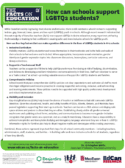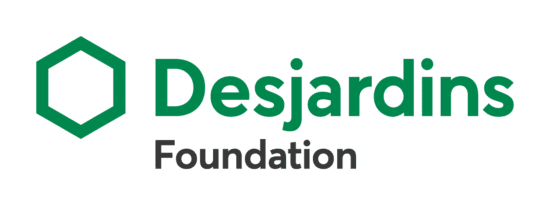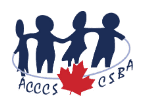How can schools support LGBTQ2 students?
Four key factors that can make a positive difference for LGBTQ2 students in K-12 schools.
While Canadian society is growing more diverse and inclusive, there is still resistance when it comes to supporting lesbian, gay, bisexual, trans, queer, and two-spirit (LGBTQ2) youth in schools. Although recent research indicates that the vast majority of Canadian teachers (85%) now support LGBTQ2-inclusive education, many report not yet having the knowledge or training to feel confident in creating safer and more inclusive schools for LGBTQ2 youth.
Here are four key factors that can make a positive difference for LGBTQ2 students in K-12 schools:
1. Inclusive Curriculum
Visibility matters. LGBTQ2 students need to see themselves in their textbooks and in the halls and walls of their schools to feel welcome and included. Where appropriate, incorporate sexual orientation, gender identity and gender expression topics into classroom discussions, lesson plans, curricular outcomes, and library collections.
2. Supportive Teachers and Staff
Teachers can be a supportive lifeline to help LGBTQ2 youth move from being at-risk of bullying, discrimination, and violence to developing a resilient mindset to overcome adversity in their lives. Staff can volunteer to serve as a “safe contact” at school – providing valuable sources of support for LGBTQ2 students and families.
3. Comprehensive Policies
School boards that pass comprehensive LGBTQ2 policies set clear expectations and authorize all staff to meet their legal obligations and become proactive in creating respectful, welcoming, inclusive, and safe working and learning environments. These policies need to be supported with high quality professional development and robust implementation plans.
4.Visibility and Inclusion
Gay-straight alliances (GSAs) help break the silence of inaction or indifference that still surrounds LGBTQ2 identities. Given the educational, health, and safety benefits of GSAs, Alberta, Ontario, and Manitoba have passed legislation supporting their start-up in schools. Teachers can become a GSA advisor and display safe space stickers and posters to show that they are allies. Establishing clearly visible all-gender universal washrooms and updating school forms, websites, and communications to become more gender inclusive recognizes that gender exists on a spectrum, not as a male/female binary. Educators have a responsibility to address homophobic and transphobic bullying and derogatory language whenever they see or hear it. LGBTQ2 information nights for families also help to dispel negative myths and stereotypes while creating awareness.
Combined, these actions represent important first steps for all school community members – including teachers, administrators, staff, students, and families – in building safer and more inclusive schools for all students, regardless of how they identify.
Additional Information Resources
- To learn more about LGBTQ2 terms and definitions, please see EGALE Canada’s Glossary
- Canadian Centre for Ethics in Sports – Creating Inclusive Environments for Trans Participants in Canadian Sport: Guidance for Sport Organizations
- Canadian National Trans Youth Health Survey
- Canadian Teachers’ Federation – Diversity and Human Rights
- Egale Canada
- Gay-Straight Alliances
- Gender Creative Kids
- Journal of LGBT Youth
- NoHomophobes.com
- PFLAG Canada (for parents, families, and friends)
- Pride Tape
- RISE: Respect, Inclusion, Safety, Equity
- SOGI 123
- Teaching Sexual Health
Government
- National Apology to LGBTQ2 Canadians
- Federal Government of Canada – Free To Be Me
- Alberta – Guidelines for Best Practices: Creating Learning Environments That Respect Diverse Sexual Orientations, Gender Identities, and Gender Expressions
- Manitoba – Supporting Transgender and Gender Diverse Students in Manitoba Schools
- Newfoundland & Labrador – Guidelines for LGBTQ Inclusive Practices
- Nova Scotia – Guidelines for Supporting Transgender and Gender Non-Conforming Students
- Quebec – Mesures d’ouverture et de soutienenverslesjeunes trans et lesjeunesnonbinaires
- Saskatchewan – Deepening the Discussion: Gender and Sexual Diversity
References
Ahuja, A., Webster, C., Gibson, N., Brewer, A., Toledo, S., & Russell, S. (2015). Bullying and suicide: The mental health crisis of LGBTQ youth and how you can help. Journal of Gay & Lesbian Mental Health, 19, 125-144.
Bartholomaeus, C., & Riggs, D. W. (2017). Transgender people and education. New York: Palgrave Macmillan.
Brill, S., & Kenney, L. (2016). The transgender teen: A handbook for parents and professionals supporting transgender and non-binary teens. San Francisco: Cleis Press.
Brill, S., & Pepper, R. (2008). The transgender child: A handbook for families and professionals. San Francisco: Cleis Press.
Genovese, M., Rousell, D., & The Two Spirit Circle of Edmonton Society. (2011). Safe and caring schools for two-spirit youth: A guide for teachers and students. Edmonton, AB: Society for Safe and Caring Schools and Communities. Retrieved from http://www.safeandcaring.ca/wp-content/uploads/2013/08/Two-Spirited-Web-Booklet.pdf
Grace, A. P., & Wells, K. (2015). Growing into resilience: Sexual and gender minority youth in Canada. Toronto: University of Toronto Press.
Luecke, J. C. (2011). Working with transgender children and their classmates in pre-adolescence: Just be supportive. Journal of LGBT Youth, 8(2), 116-156.
Mayo, C. (2017). Gay-straight alliances and associations among youth in schools. New York: Palgrave Macmillan.
Russell, S. T., & Horn, S. (Eds.). (2017). Sexual orientation, gender identity and schooling. New York: Oxford University Press.
Ryan, C. L., & Hermann-Wilmarth, J. M. (2018). Reading the rainbow: LGBTQ-inclusive literacy instruction in the elementary classroom. New York: Teachers College Press.
Short, D. (2017). Am I safe here? LGBTQ teens and bullying in schools. Vancouver: UBC Press.
Taylor, C. & Peter, T., with McMinn, T. L., Paquin, S., Beldom, S., Ferry, A., Gross, Z., & Schachter, K. (2011). Every class in every school: The first national climate survey on homophobia, biphobia, and transphobia in Canadian schools: Final report. Toronto: Egale Canada Human Rights Trust. Retrieved from https://egale.ca/every-class/
Taylor, C., Peter, T., Campbell, C., Meyer, E., Ristock, J., & Short, D. (2015). The Every Teacher Project on LGBTQ-inclusive education in Canada’s K-12 schools: Final report. Winnipeg, MB: Manitoba Teachers’ Society. Retrieved from http://news-centre.uwinnipeg.ca/wp-content/uploads/2016/01/EveryTeacher_FinalReport_v12.pdf
Travers, A. (2018). The trans generation: How trans kids (and their parents) are creating a gender revolution. New York: New York University Press.
Wells, K. (Ed). (2015). GSAs and QSAs in Alberta schools: A guide for teachers (2nd Edition). Edmonton, AB: Alberta Teachers’ Association. Retrieved from https://www.teachers.ab.ca/SiteCollectionDocuments/ATA/Publications/Human-Rights-Issues/PD-80-6%20GSA-QSA%20Guide%202016.pdf
Wells, K., Roberts, G., & Allan, C. (2012). Supporting transgender and transsexual students in K-12 schools: A guide for educators. Ottawa: ON: Canadian Teachers’ Federation. Retrieved from http://gendercreativekids.ca/wp-content/uploads/2013/10/Supporting-Transgender-and-Transsexual-Students-web.pdf



